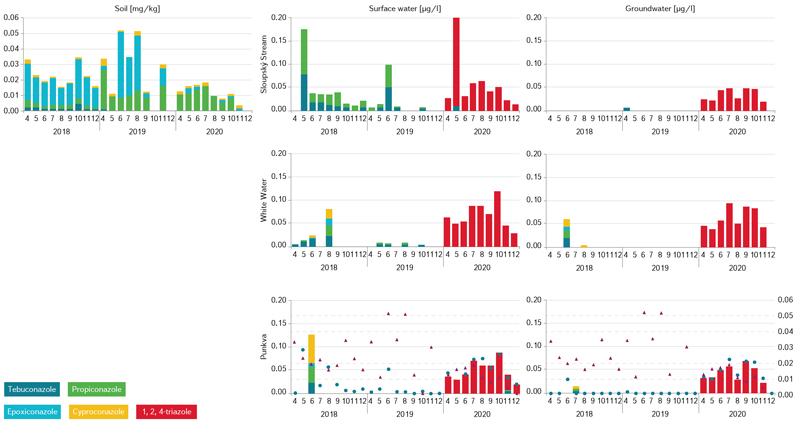SUMMARY
The Moravian Karst is the largest and most karstic area in the Czech Republic, and, as such, it is a protected landscape area (PLA). The karst area occupies a strip of Devonian limestone north of Brno. The north part of Moravian Karst is drained by the river Punkva and its headwaters. One of the biggest cave systems in central Europe is located there, Amaterska cave, which is more than 40 km long.
Despite the strict protection measures that are in place in the PLA, the presence of pollutants and potentially hazardous substances has recently been detected in the Punkva river and its catchment. The sources of this pollution are found both within the territory of Moravian Karst PLA and in the river´s catchment, and they are related to anthropogenic activities and land use. This article focuses on the occurrence of pesticides, especially triazine and azole pesticides and their polar metabolites. In 2020, a new significant contaminant, 1,2,4-triazole, a common relevant metabolite of azole pesticides, was found at the site concerned. These substances can have fatal effects not only on the endemic organisms living in the Moravian Karst, but they can also endanger human health because the local groundwater is used as a source of drinking water. Thanks to the studies carried out, the protection zones around the cave system have been extended, reducing the negative effects of agricultural activities in the area of interest.
INTRODUCTION
With an area of over 92 km2, the Moravian Karst (MK) is the largest and most important karst territory in the Czech Republic. Each karst represents an extremely fragile ecosystem, which is highly sensitive to and easily influenced by human activities, since the transport of nutrients and contaminants from soil to groundwater is accelerated due to specific pedological and geological conditions [1]. One of the possible sources of karst groundwater pollution is agricultural activity [2]. Agrochemicals such as pesticides can be transported from their direct application sites into local streams, rivers and, subsequently, into groundwater in caves. These substances can be fatal not only to the microflora and microfauna, but they also have a negative impact on higher animals´ activity and health [3]. Some pesticides are carcinogenic to humans, while others can cause serious health complications, including metabolic disorders, neurological disorders, and allergic reactions [4].
The Punkva is a subterranean river in the Moravian Karst and the longest underground watercourse in the Czech Republic. It flows through the bottom of Macocha Abyss and the system of Punkva Caves, which it co-created. The Punkva is formed by the confluence of many subterranean headwaters that flow through the limestone area from north and east to the south. These are predominantly the combined waters of the Holštejn White Water (Bílá voda) and the Sloupský Stream, which meet in the labyrinth of Amaterska cave (Fig. 1).
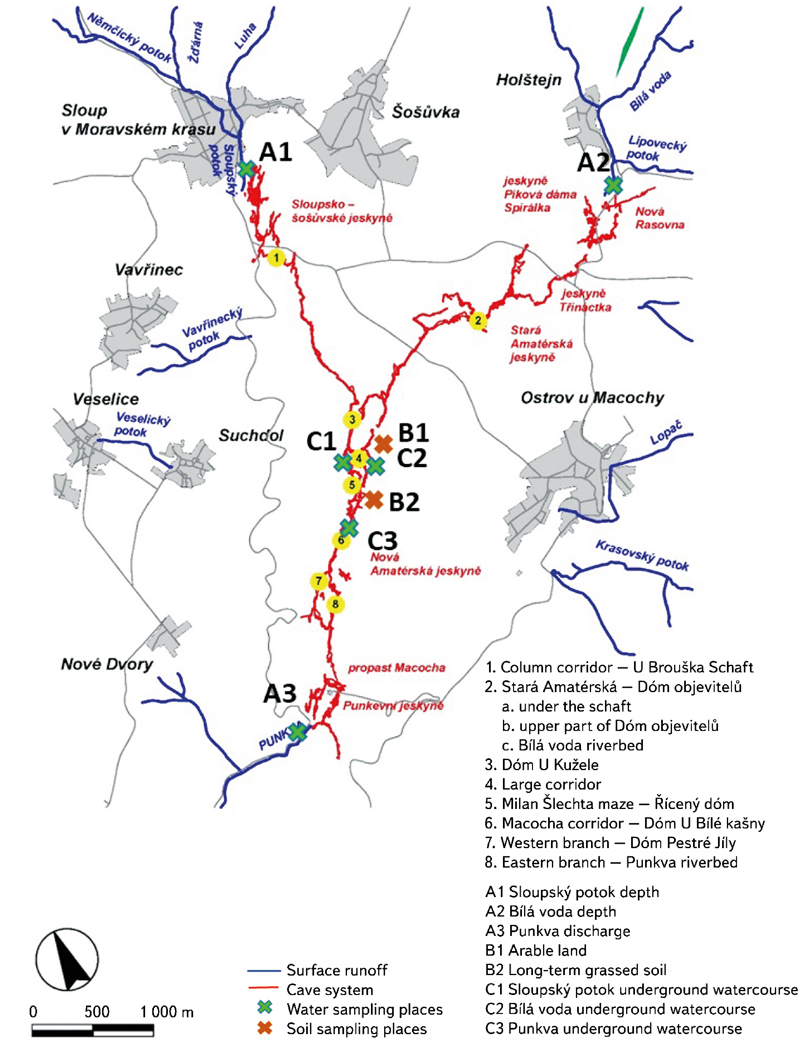
Fig. 1. Map of the Moravian Karst and monitored places (source Cave administration CR)
As PLAs are generally considered to be free of any extraneous substances, pesticide monitoring in the Moravian Karst has not been paid attention to in the past. However, Kotyzová and Halešová [5] confirmed the contamination of waters in the area with these compounds, as well as other xenobiotics. Although the pesticide residue concentrations found were not high enough to pose an acute danger to aquatic animals due to their toxicity, their long-term accumulation, the growing amount of substances used, and the formation of known and unknown metabolites of parent compounds could result in negative impacts on non-target organisms and the entire karst ecosystem.
This study aims at assessing the extent of contamination of the Punkva River with triazine and azole pesticides within the Moravian Karst.
MATERIAL AND METHODOLOGY
For the purpose of this study, water and soil samples were collected at a regular monthly interval, every second week of the month, during the period from April to December in 2018–2020. Surface water and soil samples were always collected on Thursday and subterranean samples (i.e., samples of groundwater in the caves) were collected on the following day, i.e., Friday. The water samples were taken as point samples. Soil samples were prepared as a composite sample from each site, collected using a soil probe from a depth of about 30 cm. All sampling was accredited according to EN ISO/IEC 17025 [6].
The Punkva as well as the White Water (Bílá voda) and the Sloupský Stream, whose confluence gives rise to the Punkva, are partly subterranean watercourses. Therefore, water samples were collected from the three streams, both from the surface section (Fig. 1 – sampling points A1, A2, and A3) and from the subterranean section (Fig. 1 – sampling points in the Amaterska cave C1, C2, and C3) of each stream. Soil samples were collected on the surface above the subterranean stream of the emerging Punkva River (Fig. 1 – sampling sites B1 and B2). The B1 sampling site was located where the application of selected plant protection products (PPPs) was permitted in 2018 and 2019, and the B2 sampling site was a site that has been permanently grassed since 1998. All sampling sites are summarized in Tab. 1.
Tab. 1. Identification and description of sampling points
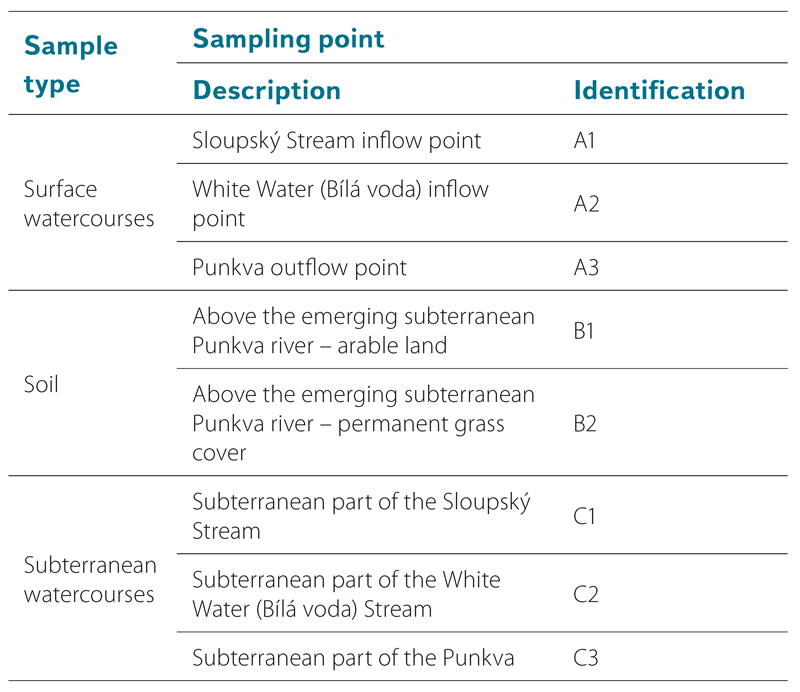
Almost 400 pesticide substances were examined in the water samples and approximately 200 pesticide substances were analysed in the soil samples. The pesticide substances were analysed on the basis of accredited methods using sensitive and selective LC-MS technique in the laboratory of ALS Czech Republic in Prague. The applied analytical methods are accredited according to Czech Standard (ČSN) EN ISO/IEC 17025 [6]. Triazine and azole pesticides and their polar metabolites showed a consistent trend and were therefore subsequently the main focus of attention (Tab. 2). Other pesticide substances were more likely to be present in the tested samples due to seasonal application of PPPs and were not present in the next sampling.
Tab. 2. Parent active substances of azole and triazine pesticide groups and their metabolites monitored in the study
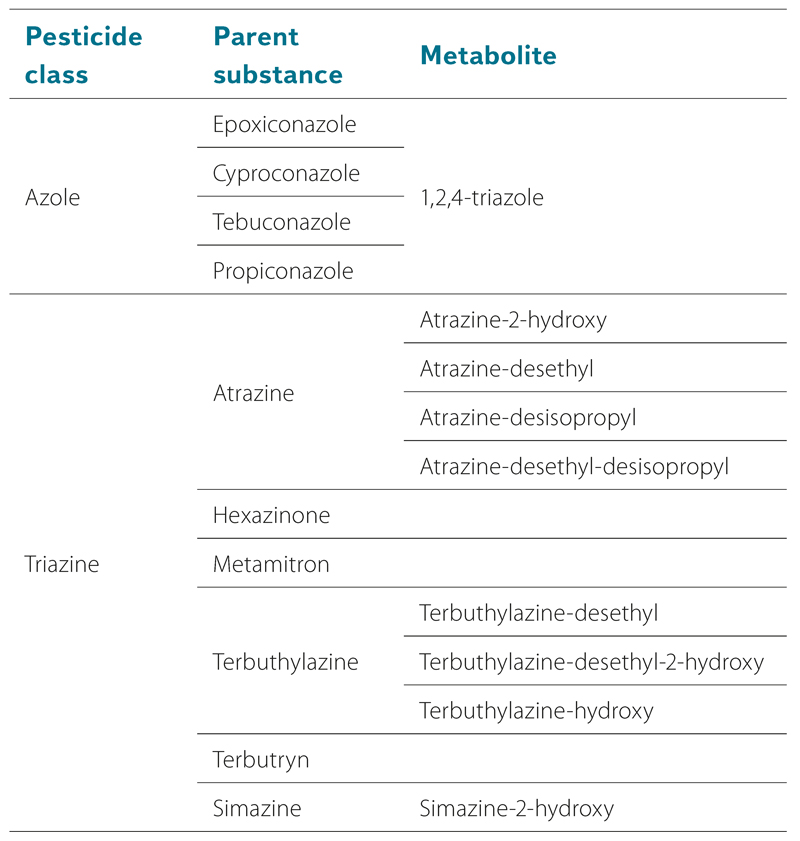
RESULTS AND DISCUSSION
Triazine herbicides and azole fungicides and their polar metabolites were detected in most of the water samples tested. Of the triazine pesticides, metabolites of terbuthylazine and atrazine were the most frequently represented (Fig. 2). It is worth noting that neither the parent active substance atrazine nor terbuthylazine were detected in any of the soil samples tested. Atrazine metabolites, especially atrazine-2-hydroxy, were significantly represented only in the B1 sample of agricultural soil. The banned atrazine was present in the surface water and mainly groundwater samples. The use of atrazine has been banned since 2005 [7]. The presence of this persistent active substance, as well as the active substance simazine and subsequently their degradation products (Fig. 2), is explained as a consequence of the application of PPPs with the active substance terbuthylazine, since both atrazine and simazine are impurities that are formed during its production. Another cause could hypothetically be the application of illegal protection products [8]. The maximum sum of triazine pesticide substances in surface water samples of the Sloupský Stream and White Water (Bílá voda) for 2018–2020 did not exceed the concentration of 0.1 mg/l; their sum for the whole period was about 0.05 mg/l on average. The main contaminants of surface water of both Punkva tributaries were metabolites of terbuthylazine (terbuthylazine-desethyl) and atrazine (atrazine-desethyl and atrazine-desethyl desisopropyl). Residues of the parent active substances terbutryn, terbuthylazine, and atrazine were also repeatedly detected in the Sloupský Stream in 2018; there were also occasional occurrences of terbuthylazine and atrazine in the White Water (Bílá voda). Contaminants from both surface streams are reflected in the occurrence of the pesticide triazine substances in the Punkva, where the sum was also a maximum of 0.1 mg/l and the average sum of pesticides over the whole period was about 0.05 mg/l. However, the difference is that, after the two tributaries enter the underground space, the decomposition of the metabolites which were previously formed on the surface and now have flowed into the underground continues under local conditions (year-round low temperature, darkness, and dissimilar organisms). Nevertheless, if parent active substances, such as atrazine, enter the karst bedrock, their subsequent decomposition underground is very slow and it leads to their accumulation and gradual transport into the Punkva river, where concentrations are higher, and the load is long-lasting.
Although the problem with triazine pesticides appears to have been eliminated, a new potential risk was discovered within the study, which the authors sought to address. In addition to triazine pesticides, azole fungicides are also widely used to treat plants. Azole pesticides (tebuconazole, propiconazole, cyproconazole, and others) are biodegradable by plants and soil microorganisms, and it is these organisms in the soil matrix that degrade the parent active ingredients to their common metabolite 1,2,4-triazole (124-TRZ), which is highly polar, mobile in soil and, therefore, a potential water contaminant. 124-TRZ is a toxicologically relevant metabolite of azole pesticides, which means that, according to legislation, its presence should be monitored and the concentration in drinking water should not exceed the limit for each individual pesticide/relevant metabolite of 0.1 µg/l. Unlike the parent substances, 124-TRZ is relatively stable in the environment, especially if it reaches groundwater where the rate of degradation is slowed down by the conditions. Its DT50 is more than 300 days, especially in groundwater [9]. Although 124-TRZ is classified as a relevant metabolite, it is quite surprising that it is still not routinely monitored and there is a lack of data and information on this compound, but this is due to the difficulty of its determination [9, 10]. Fisher et al [11] confirmed its widespread occurrence in groundwater in association with intensive agricultural land use.
Fig. 2. An overview of triazine pesticides detected in the soil and water samples in the Moravian Karst area
The results of the azole pesticide analyses are summarised in Fig. 3. It is evident that the B1 agricultural soil sample collected in the Moravian Karst was positive for the applied active substances tebuconazole, propiconazole, and epoxiconazole, while surface and groundwater samples were, with some exceptions, negative for these compounds. These results confirm that the parent azole active substances are degraded relatively early by soil microorganisms and are thus not transported into the aquatic and environmental system [12]. The fact that parent active substances of azole pesticides are applied to soil in abundance, yet their residues in water are not detected, contributed to the need for validation of the analysis and subsequent monitoring of the metabolite 124- triazole in water in 2020. The aim is to focus on the analysis of the metabolite in time to avoid future problems with exceeding its drinking water limit, as is the case with metabolites of triazine or chloroacetanilide herbicides in some areas of the Czech Republic (e. g., acetochlor, alachlor, atrazine, terbuthylazine) (e. g. [13]).
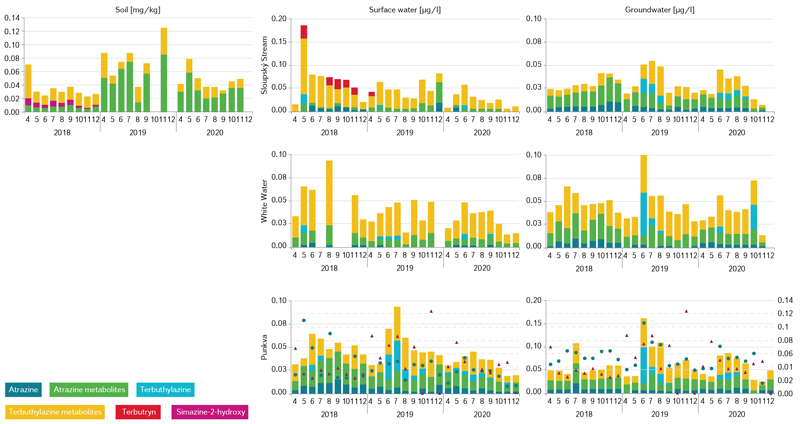
Fig. 3. An overview of azole pesticides detected in the soil and water samples in the Moravian Karst area
The results obtained within this study confirmed our assumptions that the water samples do not contain the parent azole pesticides, whereas their common relevant metabolite 124-TRZ is already present in any water type (Fig. 3), and at relatively high concentrations. Although the concentration of 124-TRZ did not exceed the recommended drinking water limit (0.1 µg/l), even in groundwater, it is alarming that all samples tested in this study since 2020 have been positive for presence this relevant metabolite. Continuous and systematic monitoring of this compound should be organised globally to avoid unwanted accumulation in the environment and subsequent elimination problems.
CONCLUSION
According to the above results, it can be concluded that triazine and azole pesticides, and their polar metabolites in particular, are common and abundant contaminants of the aquatic system in the Moravian Karst. Both groups have specific characteristics. Although the application of triazine pesticides is fortunately decreasing, their metabolites are still present to some extent in water samples. Continuous decontamination and complete removal of their residues from the environment should remain a priority. On the other hand, other unexplored and unknown compounds and metabolites are still emerging. In our case, 124-TRZ is a new interesting relevant metabolite that was detected in 2020 in all surface and groundwater samples tested, although the parent azole pesticides were absent. Not much is known about this compound, so global and national monitoring should be encouraged.
Evaluation of the results of the monitoring studies performed in 2019 and 2020 led to the modification of zones in the Moravian Karst PLA and changes in agricultural activities near the sinkholes and areas above the caves [14]. Targeted grassing was completed, which has significantly improved the quality of water infiltrating into the caves and will certainly have further positive impacts on the site in the long term.
Acknowledgements
This paper was prepared thanks to the support of the Ministry of Agriculture of the Czech Republic (within the projects QK1910282 “Options for mitigation of the impacts of extreme hydrological events in small catchments with respect to the demands of sustainable agriculture and pond aquaculture” and RO0218 “Long-term concept of development of the research organization (Research Institute for Soil and Water Conservation) for the period 2018–2022”), the support of the Technology Agency of the Czech Republic (within the project TH03030178 “New methods for assessing plant protection products risks against non-target soil organisms: Assessing risks of xenobiotics contamination on diversity”) and also in cooperation with the Moravian Karst Protected Landscape Area Administration.
The paper has been peer-reviewed
